Craigievar Castle, Scotland
There’s something about the fact that Craigievar Castle in Aberdeenshire is pink that makes it conjure fairy-tale visions. Or maybe it’s that it’s taller than it is wide: think “Rapunzel, Rapunzel, let down your hair!” Either way, it’s an enchanting sight when you first spot it from a distance and do a double-take at its color.
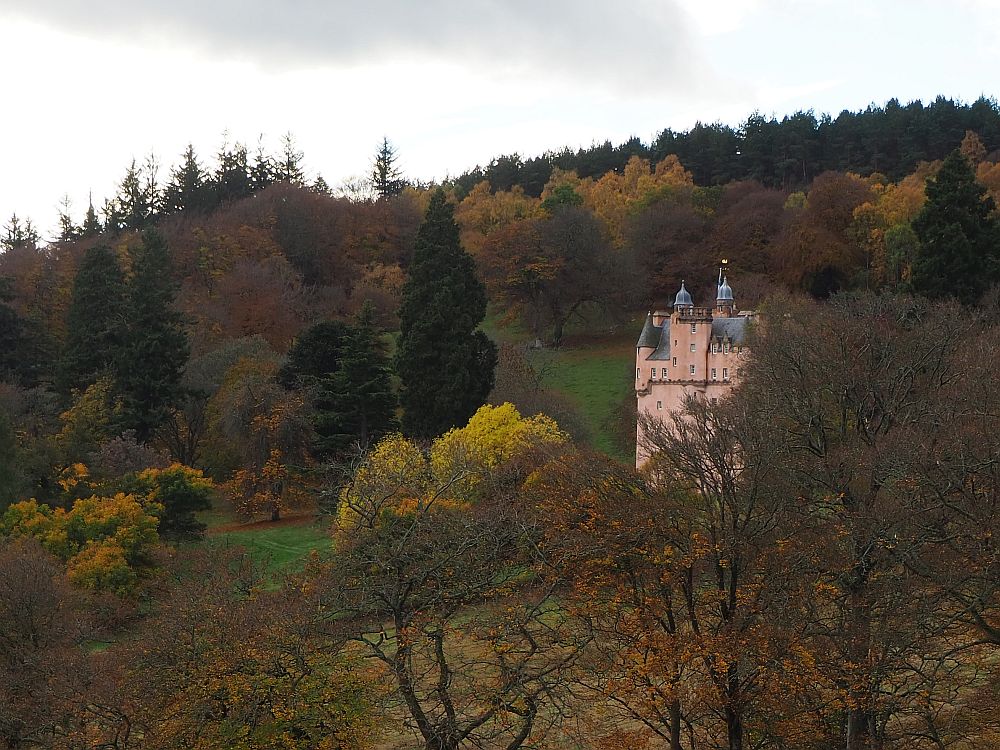
Unlike other “tower house” castles in Aberdeenshire, Criagievar Castle looks much like it did when it was completed in 1626 in Scottish Baronial style. While the bottom stories were meant for defense, the upper ones are more decorative, adding to that fairy-tale effect. The larger windows in the lower floors were added later, when defense became unnecessary. Originally, the castle had a simple defensive wall around it too, with four corner guard towers, but only one of those still stands.
The Forbes family occupied the castle for 350 years, marrying early on into the Clan Sempill, so this castle became their clan seat. William Forbes-Sempill, the 19th Lord Sempill, was the last to live in Craigievar Castle, handing it over, along with its furnishings, to the National Trust for Scotland in 1963.
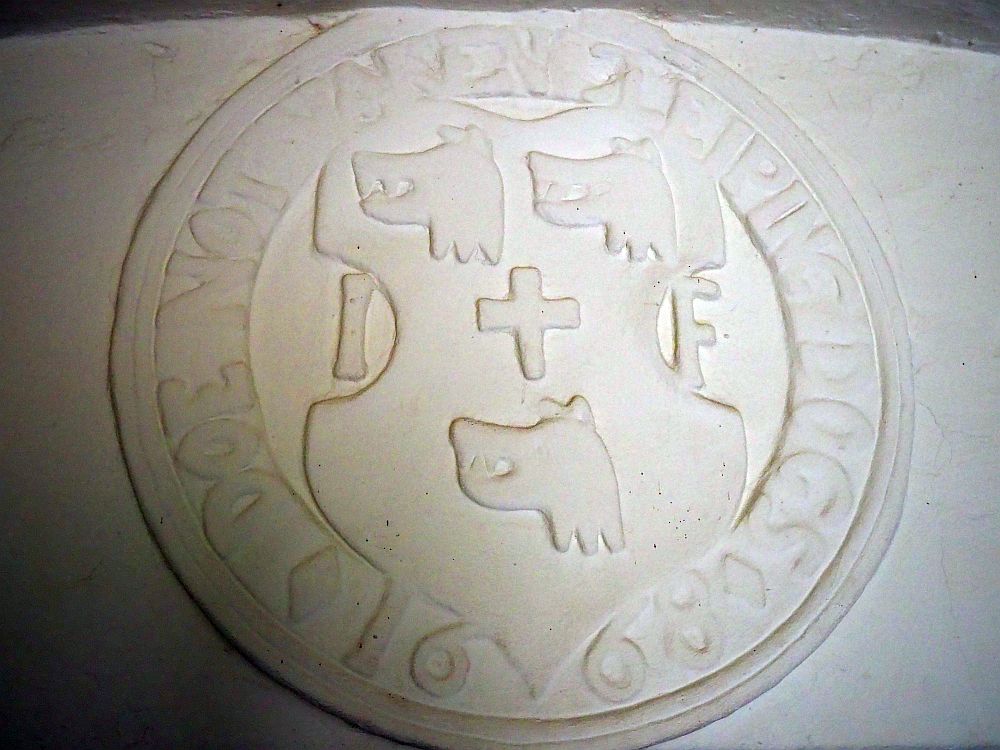
Interestingly, that last occupant stipulated that electricity may never be added above the ground floor. For that reason, the only light for visitors is the natural light through the windows. It also means that it was quite chilly when we visited in October. Presumably when people lived in the castle, fires burned in every hearth for heating, but the National Trust won’t take that risk anymore.
Unfortunately for me, The National Trust doesn’t allow photos inside the castle. I got a couple of pictures inside the entrance and then again out on the roof, but that’s it. So here’s my description of the inside.
The Great Hall at Craigievar Castle
Craigievar Castle is seven stories high, with a pink granite stairway connecting them. Our first stop was the Great Hall. We saw a large, vaulted, rectangular space with a huge fireplace on one of the longer sides and a decorative plasterwork ceiling. Our guide told us that the fireplace was used for the family’s cooking until, in the 1800s, a more modern kitchen was installed in the basement.
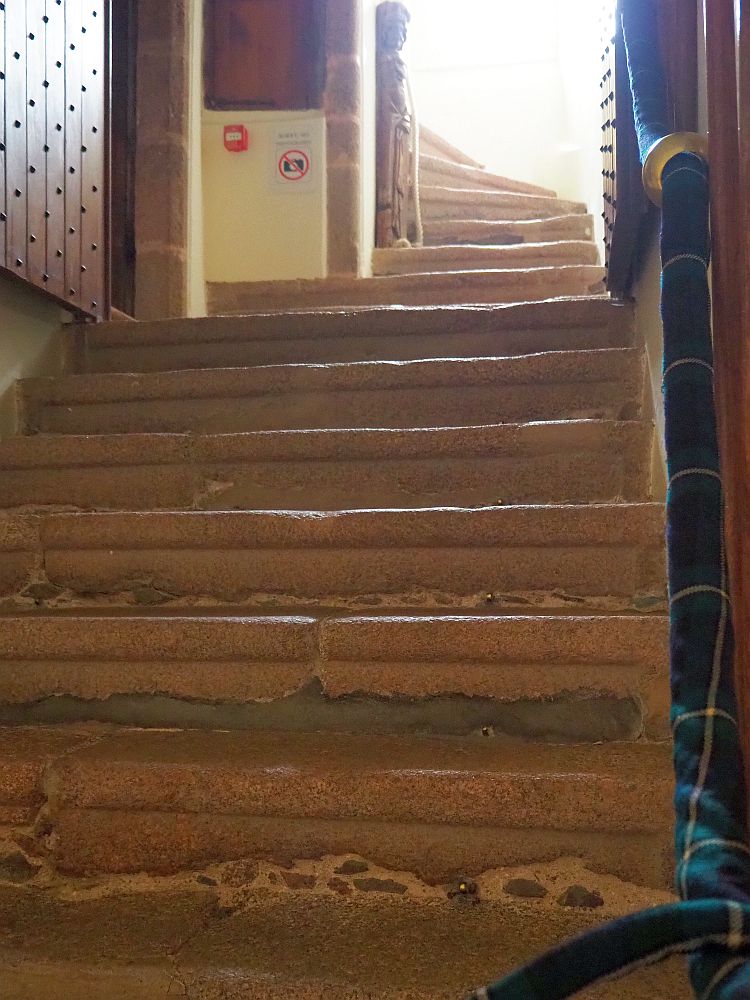
At one end of the Great Hall is a pipers’ or minstrels’ gallery, and our guide said that that small, raised gallery might have held a chapel at one time. Below the gallery is a partial wall that separates the entrance into the Great Hall from the Great Hall itself. By closing the door in this partition, the servants could stay out of sight until they were needed by one of the nobles inside the Hall. The Great Hall looks as it did when the family left, and the comfortable furnishings appeared surprisingly cozy for such a big space. In one corner is a “secret” stairway to upper floors.
Next we entered the “Lady’s Withdrawing Room,” which is self-explanatory, I suppose. It’s a small room with low ceilings and wood paneling that dates to the 1800s. This room also seems like a cozy place to be. A wooden cupboard in one corner has some really impressive inlay work.
Off the Lady’s Withdrawing Room, invisible behind a section of paneling, is a small room called the Prophet’s Chamber. During the Reformation, a visiting priest could safely be hidden here. In any case, over the centuries any visiting priest or minister would stay in this cell-like room.

The Tartan Bedroom and Craigievar Castle’s ghost
Upstairs, in the large Tartan Bedroom, our guide told a complicated story about Sir John Forbes. In his day the Forbes clan was embroiled in a long-standing feud with the Gordon clan. A member of the Gordon clan broke into the house. Sir John found him in this bedroom, cornered him using his sword and gave him a choice: die by this sword or leave out the window. The man chose to jump, and died. Sir John installed a bed with a high back, forming a wooden wall and covering up the window through which the man died. The idea, apparently, was to prevent the man’s ghost from disturbing his sleep. Nevertheless, the ghost is sometimes heard, climbing the stairs to this bedroom.
Here are some other articles you might enjoy:
Witches’ marks in Craigievar Castle
Next we saw a small dressing room, now furnished as the guestroom it was used for in the 1900s. But the next room we saw, the housekeeper’s room, was distinctly more interesting. Furnished with a “box bed” – a bed built into a cabinet in the wall – it housed, obviously, the housekeeper.
In the 1930s, though, the box bed was converted into, of all things, a bathtub or, rather, a bathtub replaced the bed inside the cabinet, along with a boiler and the accompanying piping system so the residents could have a proper hot bath. Nowadays, the building has no plumbing at all because, without heating in place, it freezes in the winter.
The original box around the space, however, remained, so the tub stands inside a closet of sorts. Today, this allows visitors to see the witches’ marks that are carved into the panels of what was once the housekeeper’s bed. Marks like these, the housekeeper must have believed, could ward off evil spirits as she slept.
The Queen’s Room
According to our guide, a legend claims that Mary Queen of Scots slept in the Queen’s Room, but she probably didn’t. The closest Craigievar ever came to such an honor was much later, when Queen Victoria did indeed visit the castle, but did not stay. In any case, the most interesting feature of this room is an “angel bed,” which means that the wooden canopy over the bed is not supported by posts at the corners. Instead, it is attached only to the wall or headboard at the head of the bed. It’s called an angel bed, according to the guide, because the canopy seems to float.
Other upper rooms
Next we saw the Blue Room, which has turrets in the corners, where we could still see the original defensive holes. In the Little Dressing Room stand a campaign bed and a chest, both of which went to the Crimean War. We also saw the Nursery/ Schoolroom and the Night Nursery/ Nanny’s Room.
On the top floor is the Long Gallery. Originally split into three rooms to house the servants, the last family to live here combined them to use for parties. Off the Long Gallery, we climbed more stairs up a tower to two small servants’ rooms. Another exit from the Long Gallery led us to the maids’ room, which has two box beds. Our guide told us that these two beds held up to eight young maids. They received their pay only once a year in May and they were allowed a day – called Mothering Sunday – to go home to give the money to their mothers.
Views from the roof
Our guide led us up to the newly renovated roof of one of the towers to see the view. Craigievar Castle is located on the side of a hill, so our view of the fields below was pretty, though I’m sure it would be even prettier in the spring or summer. A second tower next to where we stood still needs renovation before visitors can set foot on it.
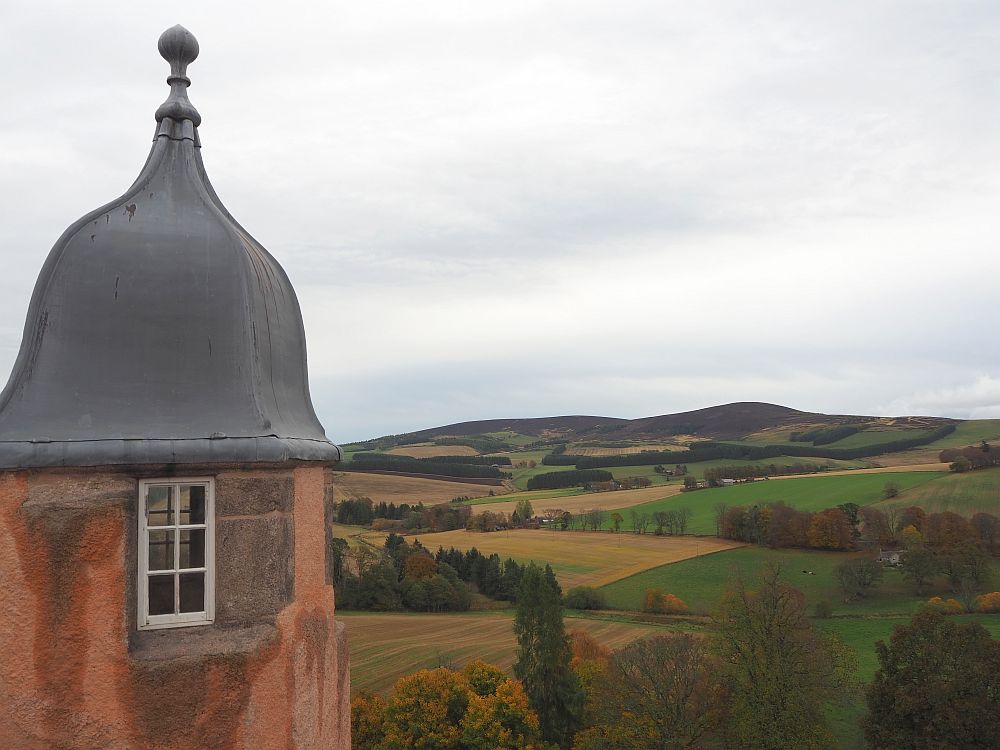
Visiting Craigievar Castle
The land around Craigievar Castle has two walking trails. One, the Woodland Trail (½ mile), snakes through farmland and woods below the castle. The other, the Craigievar Hill Trail (2 miles), climbs the hill and follows the ridge above the castle, allowing great views.
Craigievar Castle: Guided tours run about every ½ hour. First come, first served, so just show up and you should not have to wait too long.
Open daily 10:30-16:00 in June through September. In October, only Saturday and Sunday 10:30-15:00; in April and May, only Friday-Tuesday 10:30-16:00. Closed November-March. £13 ($16.50/€14.50).
Location: off the A980, six miles south of Alford, 26 miles west of Aberdeen.
If you enjoyed this article, please share it on social media. The image below is perfect for Pinterest!
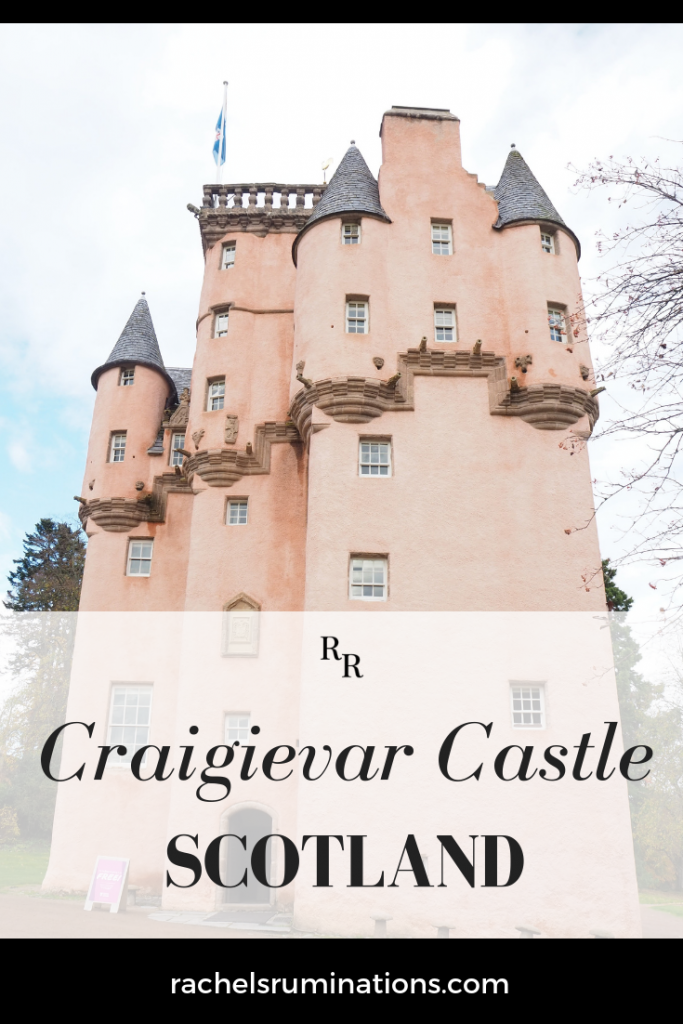



Beautiful photos of the exterior. Most interesting that the lower part was for defense and the upper decorative – in the Mani our Tower homes were built just the opposite: folks lived on the lower floors and they shot at you or dumped hot oil on you from the upper floors. 😉 A love these fairy tale settings and buildings. Keep the reports coming. Happy New Year!!
That’s true: I’ve seen more “traditional” castles that have that boiling oil feature and arrow slots, etc. for defense. But I think this was more about passive defense; they didn’t house an army there.
Another castle? And still in Scotland? And it has a ghost and witches? Gotta go check flights! Love these.
Like I wrote in the post about castles in Aberdeenshire, there are about 65 castles or castle ruins just in that one county, with 14 of them that really seem worth seeing.
Love this castle’s color! Plus a pink stairway! Does the color have any significance for the original owners?
I don’t think so. It’s something called “harling” which seems to work like a sort of stony plaster that’s applied to the outside and lasts a long time to protect the stonework and avoid the need to paint. The pigment is added to it, but why it’s pink? I don’t know.
You’ve certainly done your share of castles this past year, Rachel! I remember the year it was missions! The Craigievar Castle looks amazing!
Haha! I never did that many missions! I still have several more to write about, and I’ll certainly visit more of the Aberdeenshire ones when I next visit my son!
What a beautiful castle! Fairy tale-like and romantic. It is wonderful when families turn their properties over to the National Trust to maintain for future generations.
I agree! It must have been gut-wrenching for that last generation to hand over not only the building, but also its contents!
What an amazing visit. We have never toured a castle, let alone a pink one. Perhaps our future trips will land us in Craigievar Castle in Scotland.
Really? Oh, there are so many places I could recommend for castles! The Loire Valley in France is amazing for castle-viewing. And so is Wales, especially if you like medieval castles.
I also adore visiting castles. Craigievar Castle in Scotland has been added to my to-do list. What a shame they wouldn’t let you take pictures inside, because the images you did capture are fabulous–especially that landscape! FYI, I actually saw a small tower in Germany that is supposed to be the site where Rapunzel once dwelled.
I’ll post one soon about a similar (but not pink!) one called Crathes Castle, where I was allowed to take pictures. It’ll give you an idea of it, in any case.
Such a cute castle. I’ve only been to Edinburgh, but want to visit other parts of Scotland soon. Will add this to the list.
Cool! I pinned this. We are due for a return to Scotland and may even find time later this spring. We love referring to National Trust site. Thanks.
What a great article. Such a pretty pink colour, so much like something out of a fairytale. We haven’t been to Scotland but would definitely like to visit Craigievar Castle. Thanks for the information.